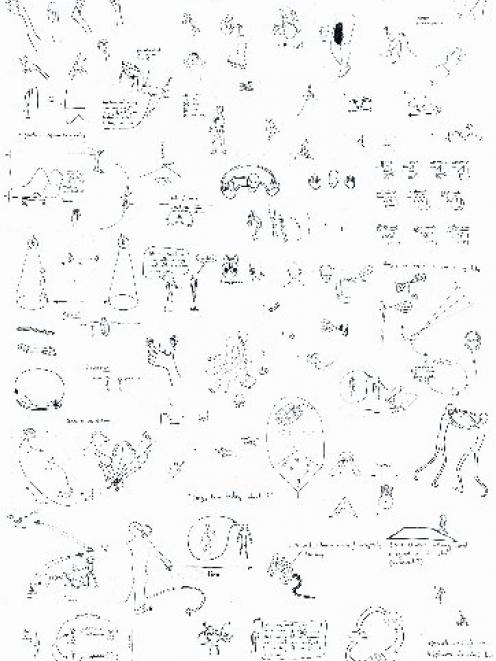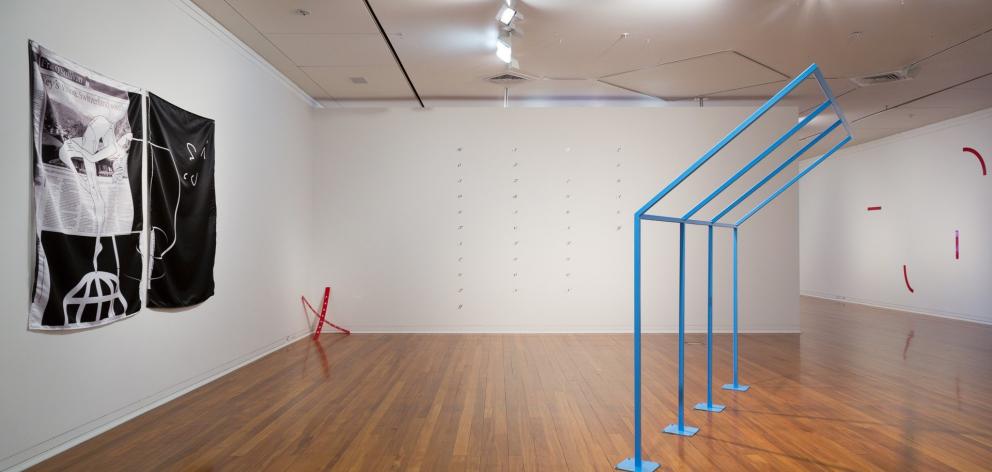In this week's Art Seen, Robyn Maree Pickens looks at exhibitions from Joshua Rutter, Matthew Galloway, and Joanna Margaret Paul
 Search Functions, by Joshua Rutter
''Flesh Perspective'', Joshua Rutter (Blue Oyster)
Search Functions, by Joshua Rutter
''Flesh Perspective'', Joshua Rutter (Blue Oyster)

A line of text taken from short statements above photographs of a washing machine/dryer in various stages of wholeness reads: ''Maybe things don't exist in and of themselves.''
This seems like a good way to approach this exhibition, which can easily be described as interactive or participatory. Rutter, who has recently completed his master's in solo/dance/authorship (Berlin), has assembled a range of everyday objects such as boxing gloves and panels of plywood and less common assemblages such as baseball caps with a single tennis ball on a cord attached to the brim, or three single ''crutches'' (a foam chinrest on a fence paling).
The crutches are for resting on, while the pile of boxing gloves on the floor have multiple potential applications: hitting the three panels of ply hinged to the wall at the bottom, which fall gently once the bungee cords holding them in place are released, punching the tennis ball on a cord that dangles in front of your face from the cap you are wearing.
If this sounds violent, it's not. There are also A4 pages with instructions on how to interact with space and time, such as: ''It takes sunlight 8 minutes to reach Earth. So. You're going to walk up Princes Street. At the speed of light.''
The tone of the works and the guiding instructions are buoyant and encouraging.
 The Freedom of the Migrant (installation view), by Matthew Galloway
''The Freedom of the Migrant'', Matthew Galloway Dunedin Public Art Gallery
The Freedom of the Migrant (installation view), by Matthew Galloway
''The Freedom of the Migrant'', Matthew Galloway Dunedin Public Art Gallery

In many respects, Matthew Galloway's exhibition turns on the irony of its title, ''The Freedom of the Migrant'', as we live in a time where ''The Unfreedom of the Migrant'' more accurately describes the global inequity and violence forcing millions from their home countries.
Galloway is concerned not only with the refugee crisis, but the ways in which this humanitarian crisis compels us to think about what nation states, belonging, borders, citizenship and responsibility mean, regardless of where in the world we live. For Sir John Key, New Zealand's relative distance from terrorist attack and the refugee crisis was a point of difference, a leveraging tool and a marketing tool to garner future investment.
Galloway's critique of this position is evident in the visual, textual and architectural forms he assembles in this impressive installation that comprises enlarged newspaper articles, flags, abstract shapes and architectural structures.
Galloway balances the density of text (newspaper articles) with skeletal architectural forms that potentially stand in for houses, prisons and buttressing frames, and with spare formal shapes of red vinyl adhered to the gallery walls.
If collected together, these vinyl fragments would possibly form an icon of the globe (a circle with longitudinal and latitudinal lines), which itself appears in part and full throughout the texts and walls of the exhibition. Galloway's takeaway newspaper contains in-depth interviews with scholars and editors.
 Spirit Hovering by Joanna Margaret Paul
''In this sensual music'', Joanna Margaret Paul (Brett McDowell)
Spirit Hovering by Joanna Margaret Paul
''In this sensual music'', Joanna Margaret Paul (Brett McDowell)

It always feels like a privilege to review the work of Joanna Margaret Paul, who, sadly, died in 2003. Each work feels like a constellation of her fluency as a visual artist, poet, and film-maker. Paul's take on perspective is idiosyncratic, unique and multi-lensed.
To take one example, her particular vision of clothes hanging on the washing line is densely constructed in bright colours; the green of the grass is luminescent.
Beneath this coloured pencil and watercolour work is the fragment In this sensual music, which has become the collective title for this presentation of Paul's drawings in a range of media: pencil, coloured pencil, pastel and acrylic.
Among the drawings are two rare oil works: one on canvas and one on paper. Waiariki, Waiora (1993), the oil on canvas, is reminiscent of a medieval painting in its triptych arrangement of landscapes glimpsed between columns and beyond facades, fences and garden arches.
Indeed, the three scenes are possibly not contiguous but the painting gains by the dynamic of plausible/implausible combinations. It shouldn't work, but it does.
In addition to landscapes, the works in this exhibition capture suburban and city views, interiors and still lifes, and an effortlessly fluid figurative study of two human forms. Several of these works are enlivened by Paul's trademark formal intervention of a line bisecting the picture plane.












